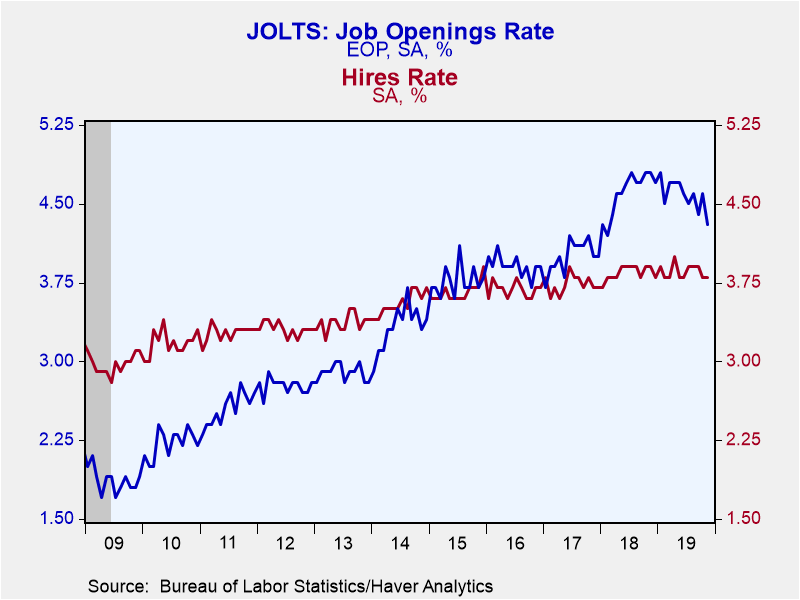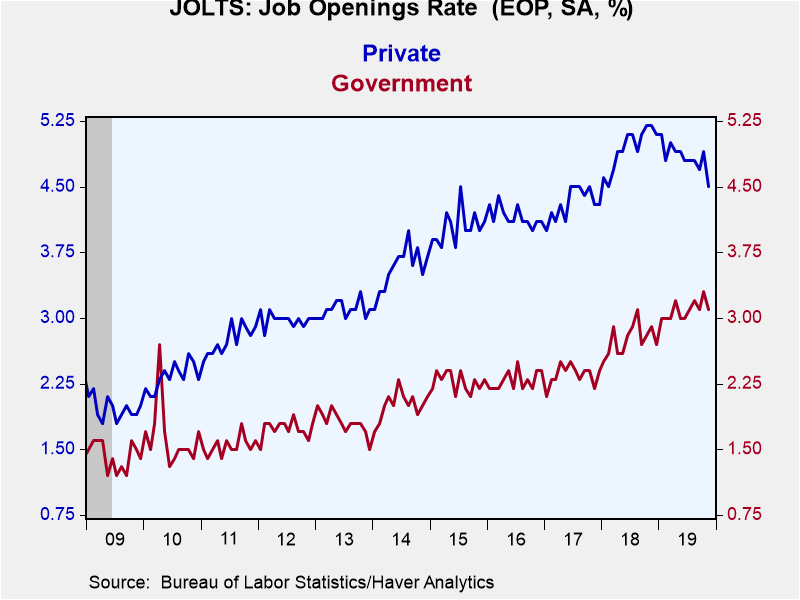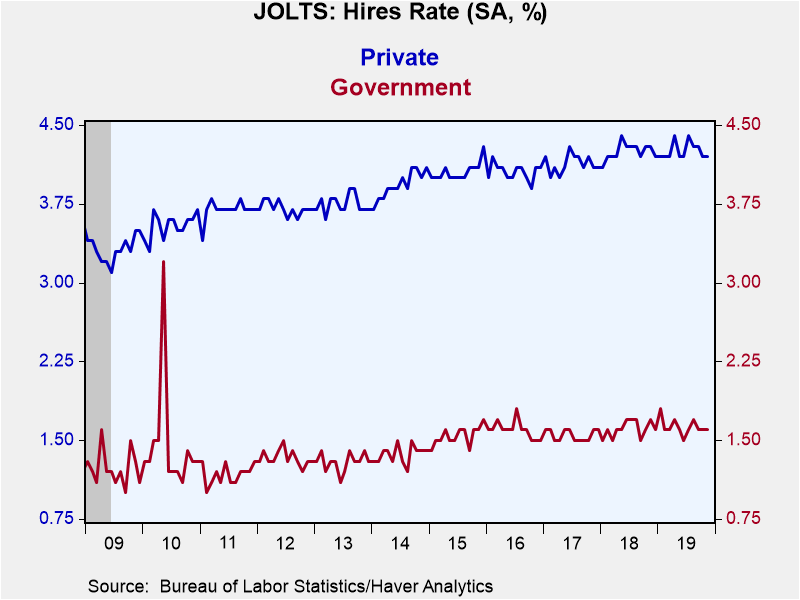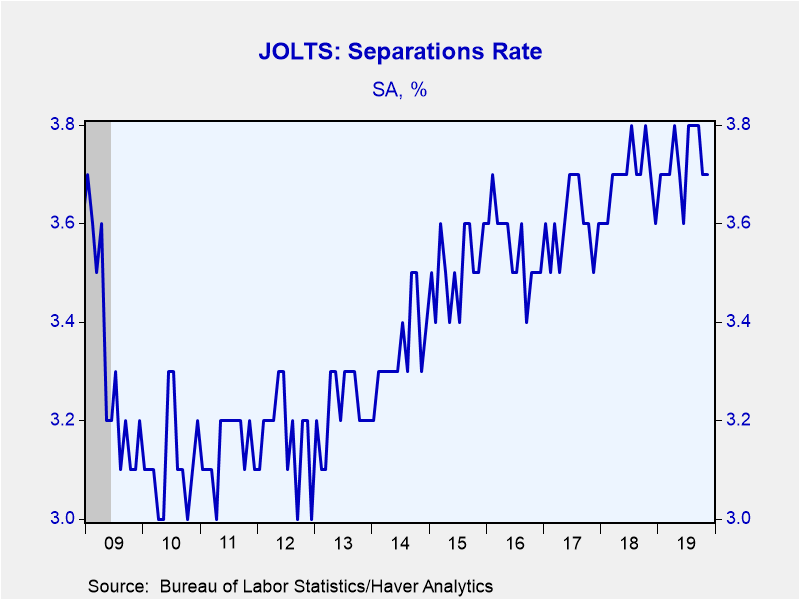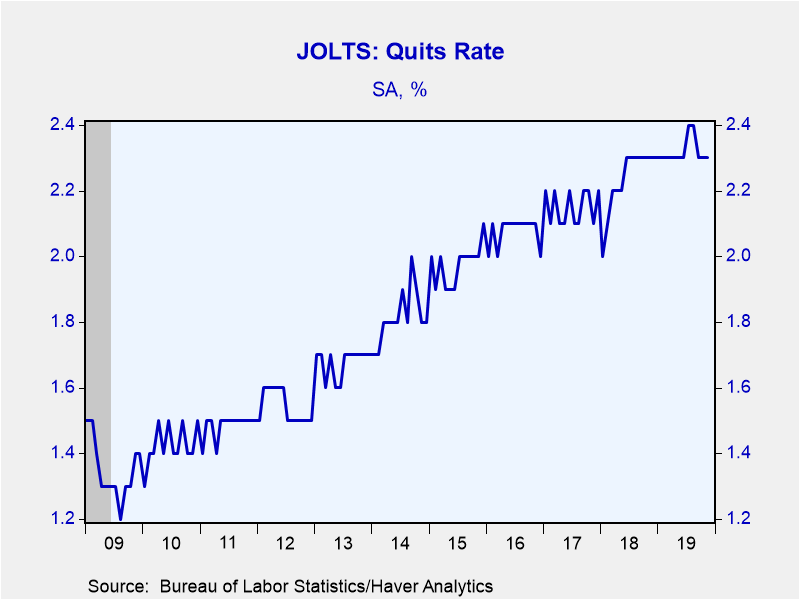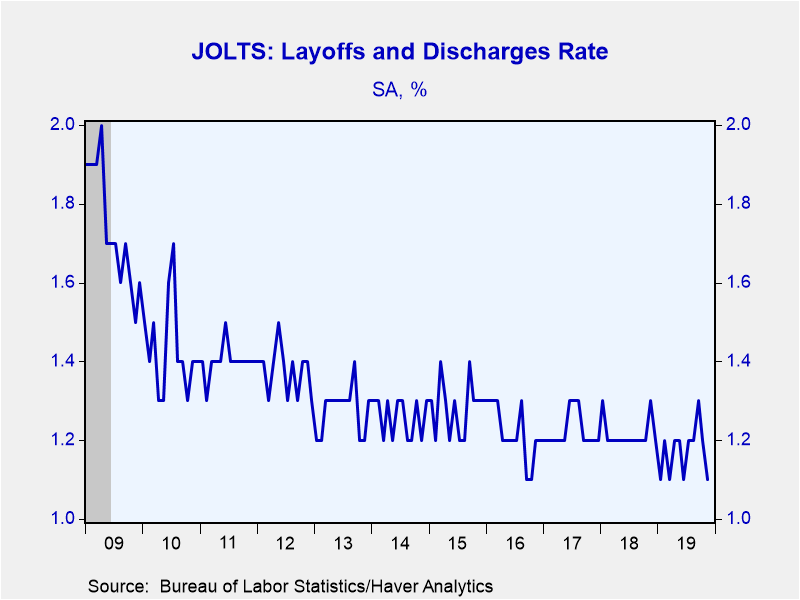 Global| Jan 17 2020
Global| Jan 17 2020U.S. JOLTS: Job Openings Decline as Hiring Turns Tepid
by:Tom Moeller
|in:Economy in Brief
Summary
The Bureau of Labor Statistics reported that the total job openings rate declined to 4.3% during November from an unrevised 4.6% in October. It remained below the 4.8% record high in January. The job openings rate is the job openings [...]
The Bureau of Labor Statistics reported that the total job openings rate declined to 4.3% during November from an unrevised 4.6% in October. It remained below the 4.8% record high in January. The job openings rate is the job openings level as a percent of total employment plus the job openings level. The hiring rate held steady at 3.8% and has been moving sideways since early last year. Employers became less inclined to let workers go. The layoff & discharge rate fell m/m to 1.1% and matched the record low. Individuals remained ready to seek new positions. The quits rate held m/m at 2.3% but has been trending higher for ten years.
The private-sector job openings rate fell sharply m/m to 4.5% and remained below the high of 5.2% twelve months earlier. The government sector job openings rate declined to 3.1%, but remained above the 2009 low of 1.2%.
The level of job openings fell 7.6% (-10.8% y/y) to 6.800 million. It was the lowest level since February 2018. Private-sector job openings fell 12.7% y/y, but government sector job openings increased 8.1% y/y.
Hiring activity remained weak in November. The private-sector hiring rate held steady at 4.2% and remained below July's expansion high of 4.4%. The hiring rate in government was unchanged at 1.6%, but below the January 2019 high of 1.8%.
Total hiring improved 0.7% but was unchanged y/y. Hiring in the private sector rose 0.4% (0.1% y/y). Government sector hiring rose 4.2%, but declined 1.1% y/y.
Individuals are ready to find new work. The overall job separations rate held at 3.7%, just below the expansion high. The private sector separations rate held steady at a firm 4.1%. The separations rate in government fell slightly to 1.5%.
The total level of separations rose 0.9% y/y but the level has fallen recently. Private sector separations rose 1.3% y/y but separations in the government sector declined 4.4% y/y.
Confidence in finding work improved last month. The level of quits rose modestly m/m and remained up 4.6% y/y. The quits rate held steady m/m at 2.3% and was sharply higher versus 1.3% at the beginning of the expansion. The private-sector quits rate remained high at 2.6%, increased from 1.4% in the fall of 2009. The government sector quits rate of 0.8% held steady m/m, but was double the rate at the beginning of the economic expansion.
The level of layoffs continued to reverse its earlier monthly increases and fell 7.4% y/y. In the private sector, layoffs declined 7.3% y/y as the layoff rate held at a lessened 1.3%. It remained below the 2009 high of 2.2%. Layoffs declined 10.0% y/y in the government sector, and the layoff rate was 0.4%.
The Job Openings & Labor Turnover Survey (JOLTS) dates to December 2000 and the figures are available in Haver's USECON database.
| JOLTS (Job Openings & Labor Turnover Survey, SA) | Nov | Oct | Sep | Nov'18 | Nov'17 | Nov'16 |
|---|---|---|---|---|---|---|
| Job Openings, Total | ||||||
| Rate (%) | 4.3 | 4.6 | 4.4 | 4.8 | 4.0 | 3.9 |
| Total (000s) | 6.800 | 7.361 | 7,032 | 7,626 | 6,163 | 5,862 |
| Hires, Total | ||||||
| Rate (%) | 3.8 | 3.8 | 3.9 | 3.9 | 3.7 | 3.7 |
| Total (000s) | 5,821 | 5,782 | 5,951 | 5,877 | 5,587 | 5,177 |
| Layoffs & Discharges, Total | ||||||
| Rate (%) | 1.1 | 1.2 | 1.3 | 1.3 | 1.2 | 1.2 |
| Total (000s) | 1,749 | 1,795 | 1,971 | 1,889 | 1,738 | 1,772 |
| Quits, Total | ||||||
| Rate (%) | 2.3 | 2.3 | 2.3 | 2.3 | 2.1 | 2.1 |
| Total (000s) | 3,536 | 3,497 | 3,471 | 3,379 | 3,156 | 3,006 |
Tom Moeller
AuthorMore in Author Profile »Prior to joining Haver Analytics in 2000, Mr. Moeller worked as the Economist at Chancellor Capital Management from 1985 to 1999. There, he developed comprehensive economic forecasts and interpreted economic data for equity and fixed income portfolio managers. Also at Chancellor, Mr. Moeller worked as an equity analyst and was responsible for researching and rating companies in the economically sensitive automobile and housing industries for investment in Chancellor’s equity portfolio. Prior to joining Chancellor, Mr. Moeller was an Economist at Citibank from 1979 to 1984. He also analyzed pricing behavior in the metals industry for the Council on Wage and Price Stability in Washington, D.C. In 1999, Mr. Moeller received the award for most accurate forecast from the Forecasters' Club of New York. From 1990 to 1992 he was President of the New York Association for Business Economists. Mr. Moeller earned an M.B.A. in Finance from Fordham University, where he graduated in 1987. He holds a Bachelor of Arts in Economics from George Washington University.


